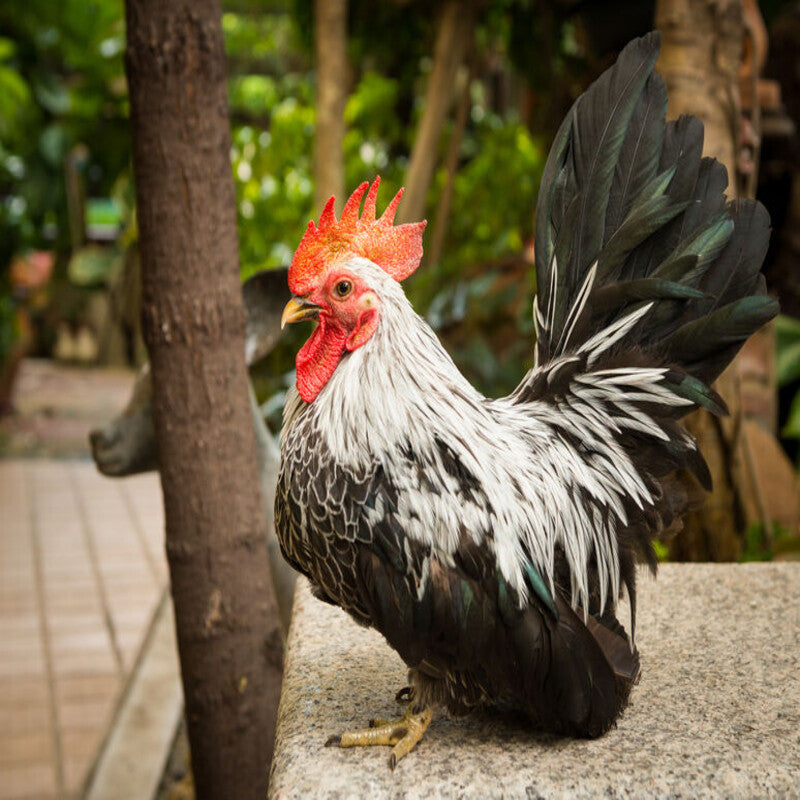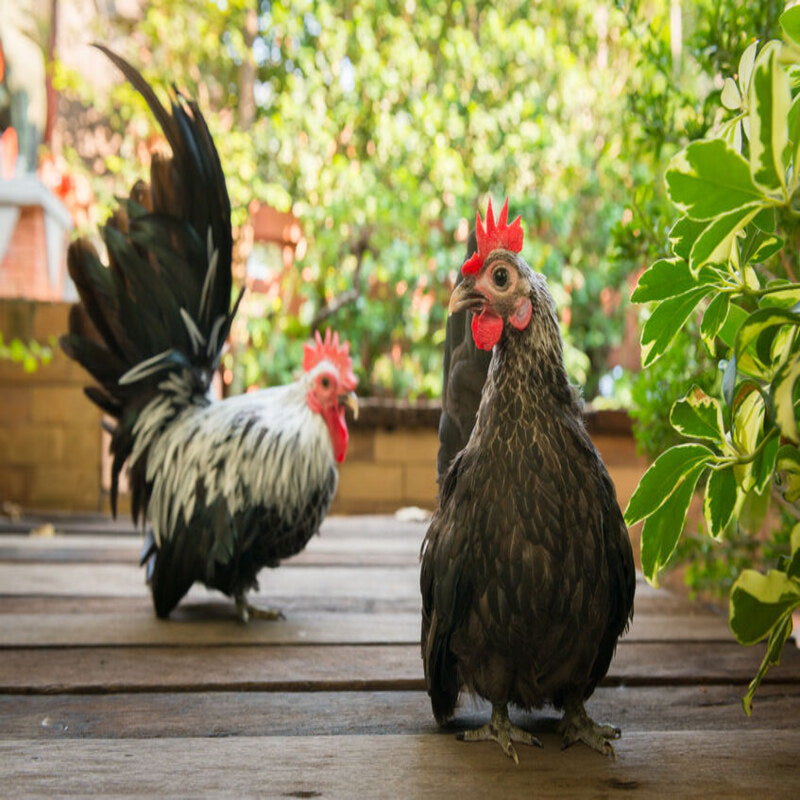-
Egg Size
Small
-
Egg Quantity
Fair (2/wk)
-
Egg Color
Cream, White, Tinted
-
Abundance
Rare
-
Cold Tolerance
Hardy In Winter
-
Heat Tolerance
Not Especially Heat Tolerant
-
Size
Bantam
-
Personality
Active
-
Feathered Feet
No
Gray Japanese Bantam
Gray Japanese Bantam Chicken
At Chicken Coop Company, we offer a stunning selection of Japanese Bantams, one of the most eye-catching miniature chicken breeds. Among these is the Gray Japanese Bantam, known for its beautiful gray and black feathering, short legs, and large comb. Japanese Bantams are excellent pets, needing minimal space and feed to thrive.
They’re perfect for small setups and make friendly, low-maintenance companions. Order your baby chicks today, and we’ll ensure your Gray Japanese Bantams arrive promptly. Please note that Japanese Bantams carry the unique Lethal Creeper gene, which influences their leg length.
Health and Care:
-
Hardy and Resilient: The Gray Japanese Bantam is a hardy breed, well-suited to a variety of climates, particularly in moderate and mild weather. Their small size and compact frame allow them to handle both cold and hot conditions relatively well, but they should be protected from extreme weather. In colder climates, they will need shelter from the cold, and in hotter climates, they should have access to plenty of shade and fresh water to stay comfortable.
-
Disease Resistance: These bantams are generally healthy and disease-resistant but can be susceptible to the common issues faced by poultry, such as mites, lice, and respiratory problems. Regular health checks, grooming, and keeping the coop clean will help maintain their overall health.
-
Low Maintenance: The Gray Japanese Bantam is relatively low-maintenance. They require a balanced diet, fresh water, and a clean living space. Their small size means they don't require much room, but they do enjoy having access to free-range areas where they can forage and engage in natural behaviors.

Egg Laying:
-
Moderate Egg Production: Like other bantam breeds, the Gray Japanese Bantam is not a prolific egg layer. They typically lay 100-150 small white eggs per year. Their egg production is steady but not as high as other commercial laying breeds. Their small size and primary purpose for ornamental purposes mean they are not specifically bred for high egg yield.
-
Seasonal Laying: The Gray Japanese Bantam's egg production may slow during the winter months when daylight hours are shorter, though providing supplemental lighting can help maintain egg production during the colder months.
-
Small White Eggs: The eggs laid by the Gray Japanese Bantam are typically small, white, and of good quality. These are ideal for personal consumption or small households.
Temperament:
-
Active and Spirited: The Gray Japanese Bantam is known for its active, spirited nature. They are a gamebird-type breed, meaning they are agile, energetic, and love to roam. They enjoy free-ranging and are typically seen foraging for food or engaging in natural behaviors.
-
Confident and Proud: These bantams have a confident and proud demeanor, often holding themselves upright and walking with an elegant gait. Their confident posture and alertness make them stand out in any flock.
-
Friendly but Independent: While the Gray Japanese Bantam is generally friendly, they can also be somewhat independent. They enjoy human interaction, but they are not as clingy or social as other more docile breeds. Their independent streak means they are better suited for people who want an ornamental bird with a bit of personality.

Appearance:
-
Elegant Gray Plumage: The Gray Japanese Bantam is known for its distinctive gray feathers, which can range from a soft light gray to a slightly darker charcoal gray. The feathers often have a slightly iridescent quality, giving the bird a refined and elegant look. Their gray coloring is contrasted by the bright red comb and wattles, which provide a striking visual balance.
-
Compact and Slender Build: These bantams have a slender, compact build that is typical of the Japanese Bantam breed. They have a long neck, graceful body, and small, rounded head, giving them an overall refined appearance. Their lightweight frame and small size contribute to their agile and quick movements.
-
Unique Tail and Posture: One of the most defining features of the Gray Japanese Bantam is its long, elegant tail, which is held upright or slightly curved. This adds to the bird’s graceful posture and is one of the characteristics that make Japanese Bantams popular in poultry shows.
-
Small Comb and Wattles: The Gray Japanese Bantam has a small single comb that is red, as well as small wattles. These features add a splash of color and contribute to their overall delicate, yet bold appearance.
-
Bright Eyes and Alert Expression: Their bright, expressive eyes are one of the most striking features of the Gray Japanese Bantam, giving them an intelligent and alert appearance. Their sharp gaze is fitting for a breed that is known for being active and quick to respond to changes in its environment.
Frequently Asked Questions:
What is a Gray Japanese Bantam?
A miniature chicken breed with gray and black feathers, short legs, and a large comb.
Are Japanese Bantams good pets?
Yes, they make friendly pets and require minimal space and feed.
What is the Lethal Creeper gene in Japanese Bantams?
A genetic trait that affects leg length, unique to Japanese Bantams.
Do Gray Japanese Bantams need a lot of space?
No, they are small and do well in compact setups.
Where can I buy Gray Japanese Bantam chicks?
Available at Chicken Coop Company—order now for quick shipping!
Gray Japanese Bantam Facts
- Poultry Show Class: Single Comb Clean Legged (Other than Game) Bantams
- Weights – Hen ——-22 oz
- Rooster—-26 oz
- Pullet——20 oz
- Cockerel—22 oz
- Purpose and Type: Ornamental; Production
- Egg Shell Color: Cream or Tinted bantam sized eggs
- Egg Production: Fair
- Egg Size: Small
- Temperament: Active
- Fertility Percentage: 40-55%
- Broody: Variable
- Mating Ratio: 6 Females to 1 Male
- Roost Height: 2 to 4 feet
- Country of Origin – Japan
- APA: Yes, Recognized by the Standard of Perfection in 1914
- TLC: Yes, Threatened Status
- Breeder Farm Source: Poultry Breeding Farm has been developing our bloodline/strain of Japanese Bantam chicken breed since 1973.
Notice: We do not sell items on Amazon or other websites.






